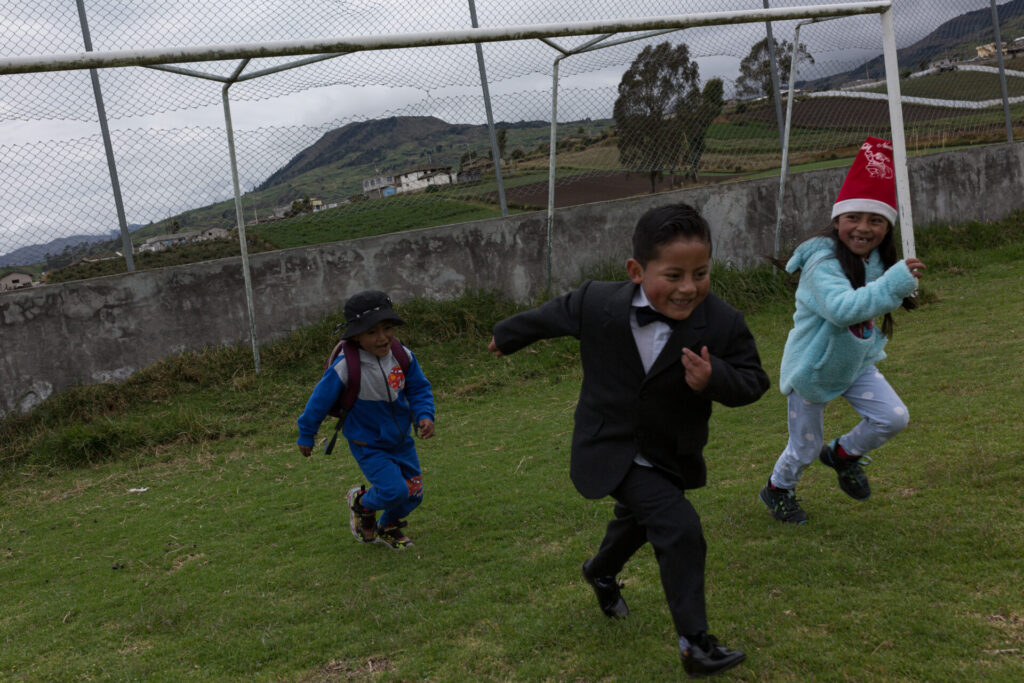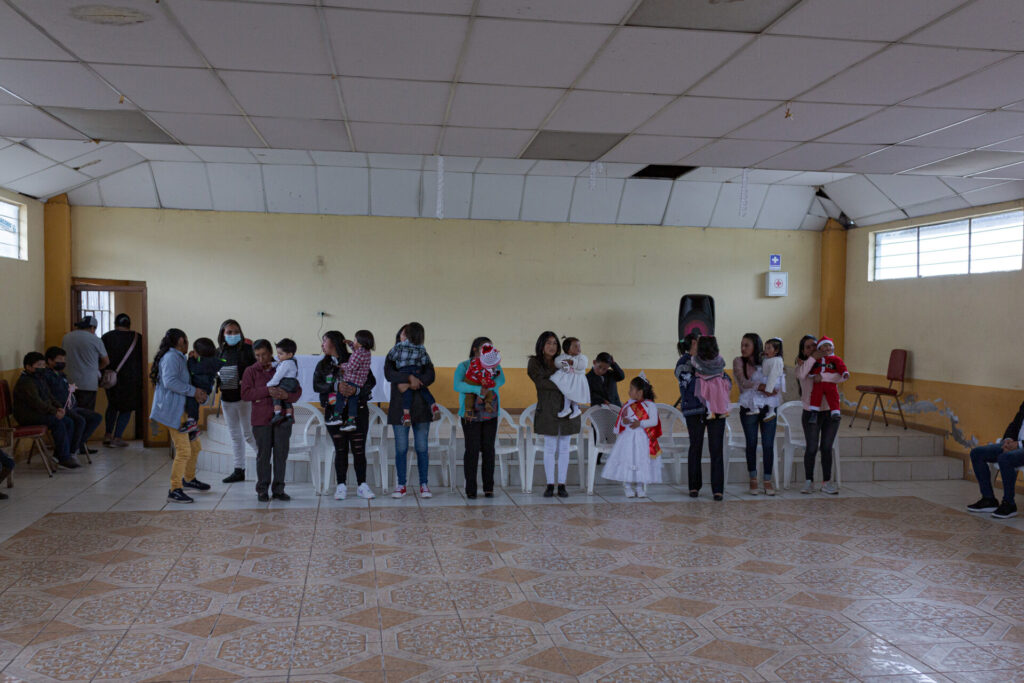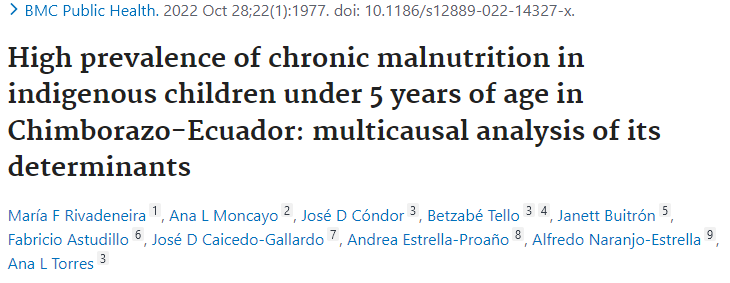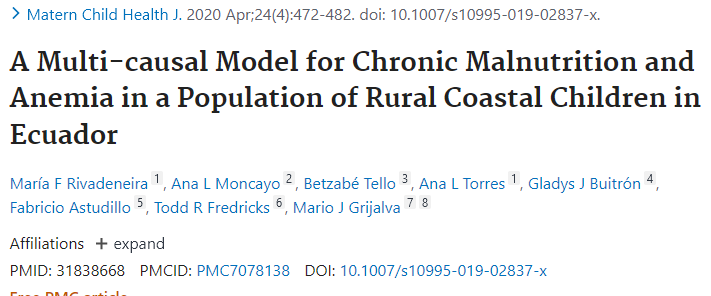Back there, intertwingled with the clouds, is the snowy mountain of Carihuairazo. The altitude here in the town of Tisaleo is more than 3.200 meters above sea level. Up here the air is dry. This area is known for agriculture, potatoes, beans, peas, corn, blackberries, and strawberries. Here is at first sight no lack of food.
But then again. The province of Tungurahua – of which Tisaleo is a part – has the highest statistics of chronic child malnutrition in the country with 41.34 % of children 0-2 years old, according to the National Institute of Statistics and Census in Ecuador (INEC). Most of the food they cultivate is to be sold and consumed elsewhere.
Diana Belén Pilco Pilco, 36, is preparing her son Lucio, almost two years old, for a small Christmas parade through the part of Tisaleo called El Calvario. She is the treasurer at the local CNH group (Creciendo con Nuestros Hijos – Growing with Our Children) in the Calvario sector – a government initiative for vulnerable children regarding malnutrition. The group in El Calvario consists of 16 children and their parents – the majority have a really low income and several are single mothers. They work in agriculture or in footwear manufacturing. Most work daily, seasonally – not with a fixed monthly income. On the days they work they can earn around 12 USD (the currency in Ecuador) per day.
Being a part of the CNH group, they get visits once a week. Sometimes they would get eggs or hens from the group initiative.
The pandemic has been hard on them, Diana recons. And in general, their difficult economic conditions make it hard for them to offer healthy and good food to their families:
“We talk about that among the mums because they give us talks about nutrition for our children they give us training, but as the doctor sometimes tells us, the nutritionist tells us what we have to feed our children, but there are times when we don’t have the access to give them one egg a day. And even worse to buy meat, chicken, and fish because they are more expensive products, and we don’t have enough money to buy them. The doctor told us that we must try to give them as much food as possible, and sometimes there is not enough, we give them what we have at home, and sometimes that is also why this happens with malnutrition in our children.
Diana’s son Lucio suffers from malnutrition and anemia, she tells us. And as a mother, it is really difficult, not being able to treat and feed well your children:
“It is difficult, it is helplessness we feel because sometimes when there is enough, we feed ourselves and we feed good, but when there is not, sometimes, no matter how much we want to, we cannot. We give what we have from our pocket. But sometimes there is nothing. And unfortunately, those who pay the consequences are our children,” says Diana.
But equally, Diana and the other mothers try their best to improve their conditions and get better access to food for their children. For instance, they plant vegetables like chard or peas– which would be too expensive to buy. They also raise guinea pigs to sell – which is a traditional food in Ecuador.
Diana points out another thing that would be a great help for the families in Tisaleo. To get a local pediatrician, so that they would easily and quickly be able to bring their small children to medical checks.
And poverty plays a central role in the predisposition for malnutrition among children. So, explains Betzabe Tello, who is a Family Doctor, has a Ph.D. in medicine, and is a research professor at the Pontifical Catholic University of Ecuador (PUCE), where she has published studies related to chronic child malnutrition. She has also collaborated with the United Nations Children’s Fund, UNICEF, and with the Ecuadorian Ministry of Public health on this topic.
“Chronic child Malnutrition is a serious public health problem in Ecuador, and it is only getting worse. Poverty is the most important determinant of malnutrition. 40% of children under 5 in Ecuador live in the poorest parts of the country. That is quite a lot. Also, the ethnic population, the indigenous population is the most affected – by poverty and by malnutrition. Education of women is also a determinant for the malnutrition of children,” explains the researcher.
According to data from UNICEF, 40 % of malnourished children in Ecuador are indigenous even though the indigenous population only makes it up for seven percent of the total population.
At the level of Ecuador, it is the Central Andean Provinces, like Tungurahua where Diana is living, which are most affected, here half of the children suffer from malnutrition, which is a serious issue. Here lives the poorest population, almost entirely indigenous population.
“There is no quick solution, because of the political panorama, the political decisions are not tackling the structural problems of malnutrition. It is not just about food but also access to healthcare, clean water, and education. For the prevalence of malnutrition to disappear, we must look at narrowing the inequality gap”
Ricardo Fabricio Huaraca is the local doctor in the El Calvario sector, where there are living 2.646 persons. He points out several reasons for the record-high level of chronic child malnutrition in the area:
“We have a high rate of child malnutrition. There are several precarious situations contributing to that, like the water here in the Calvario area in general, is not drinkable. This is a factor that influences malnutrition and in addition to this the parasites that are quite frequent here, that is another important factor that we have,” says the local doctor.
He agrees on the lack of access to healthy food is a key element in the problem, but not the only one:
“Access to an adequate and balanced diet is very complicated at times due to the precariousness of the parents’ access to food. Sometimes it has not been possible to carry out many check-ups, obviously here as the population is quite dispersed and there is not much staff at times to be able to carry out the necessary technical visits by our health personnel,” says Ricardo Fabricio Huaraca.
Another of the members of the CNH group is 23-year-old single mother Erika Lizeth Panimboza with her son Gael, 1. She has been living her whole life in Tisaleo. Being a single mother, is tough, especially economically, she tells:
“We lack food because even though I work hard, sometimes I can’t afford to buy all the necessary things for him, like yogurts, for example, I can’t afford to buy all that,” says the young Ecuadorian mother.
Her son is suffering from malnutrition, she has been told by the doctors:
“My son has short stature and does not have a very good weight. I don’t know what it’s due to, but I’ve been told that it’s because of his poor diet, because he doesn’t eat properly like yogurts, cereals, fruit, and all that because I don’t have a lot of money. I do worry because I don’t have enough money to buy enough things for him,” says Erika.
Another big wish of hers is a hospital in Tisaleo that will attend 24 hours a day, to get better medical attention, especially for small children like her son Gael.
Studies from before the pandemic showed that almost half of Ecuadorian families didn’t have access to an adequate and balanced diet. And during the pandemic, those things got worse. A condition with serious consequences for the children, their families, and the whole country. Something the Ecuadorian researcher is really worried about:
“Immediate consequence of malnutrition can be infectious diseases or even premature death. Then there are the long-term consequences, which are many, obesity, diabetes, and lack of productivity. A small child is not just small in size but also its head, thoughts, and aspirations are small and limited. That can lead to a lack of productivity, lack of access to adequate work, and poor living conditions. And in general, a lack of productivity in the country. Chronic child malnutrition also weighs on the country’s economy in the end. And all this is more likely to be passed on to the next generation, end the end we are doomed to poverty,” thinks Betzabe Tello.
Ecuador is the country in South America with the highest rate of chronic child malnutrition and the second in Latin America (after Guatemala) according to UNICEF. One-third of children in Ecuador are malnourished.
The Ecuadorian doctor points out, that her country could learn something from neighboring Peru:
“In Peru, they seem to have done something right, according to the Ecuadorian researcher: “They have managed to reduce malnutrition because they have had a very strong policy – they kept during different governments, with a strict budget allocation to this area. They managed to reduce malnutrition; they’ve had an anemia policy too”.
Lise Josefsen Hermann – a freelance journalist based in Latin America for more than a decade. She is a Pulitzer Grantee, works for the investigative media Danwatch and has published in media like Al Jazeera, BBC, Deutsche Welle, Danish Broadcasting Corporation, El Pais, New York Times, and Undark Magazine. Photo: Charlie Cordero, Cesar, Colombia.








